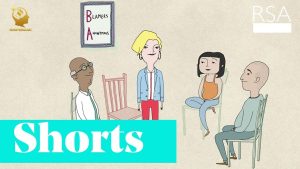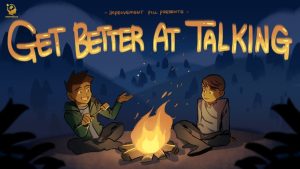
Beginner
- Task 1: The Main Idea Tell a partner what the main idea of the video is. Why is it helpful to understand your brain? Use simple sentences.
- Task 2: Describe a “Character” The video talks about four parts of the brain as “characters.” Choose one of the characters below and describe it to a partner.
- Left Thinking (e.g., counting 1+1=2)
- Right Emotional (e.g., feeling the water)
- Task 3: My Feelings The speaker says that getting to know your brain can bring “less anxiety and more peace.” Talk with a partner about a time you felt anxious or peaceful. What was happening?
Intermediate
- Task 1: The Stroke Experience The speaker talks about having a stroke. Tell a partner what happened to her left hemisphere. What did she lose? What did she still have?
- Task 2: The Four Characters Explain the four “characters” of the brain to a partner. Give an example of a time you have used each part.
- Left Thinking: (e.g., planning a trip)
- Left Emotional: (e.g., remembering a past event)
- Right Emotional: (e.g., enjoying a moment right now)
- Right Thinking: (e.g., feeling connected to the world)
- Task 3: Personal Freedom The speaker says that understanding your brain gives you “personal freedom” to choose how you want to be. Do you agree with this? Discuss with a partner what this “personal freedom” means to you.
Advanced
- Task 1: The “Collective Democracy” The speaker talks about living as a “collective democracy inside our own head.” What does she mean by this? What does she say happens if we only live based on the values of the left hemisphere?
- Task 2: Discuss the “Grief is Not a Lifestyle” The speaker says, “grief is not designed to be a lifestyle.” Discuss this quote with a small group.
- What does she mean by this?
- Do you agree with her?
- How can a person learn from an emotion like grief without living in it?
- Task 3: Brains and Biases The speaker talks about how the emotional part of the left hemisphere can make us feel “constricted” and lead to a “we versus they” mindset.
- Discuss with a partner how understanding this part of the brain can help with biases and create a healthier world.
- What specific things can a person do to avoid this “we versus they” mentality?
Beginner
- Task 1: Listen for the Main Idea Listen to the video. What is the main topic? Choose the best answer: a) The brain and exercise b) How to find a job c) Why rejection hurts
- Task 2: Listen for Keywords Listen carefully to the video. Put a check mark next to the words you hear.
- happy
- painful
- brain
- feel
- strong
- job
- love
- Task 3: Listen and Complete Listen to the video and fill in the missing words.
- Rejection hurts. It’s incredibly ____________ to feel like you’re not wanted.
- The pain you’re feeling is just part of a system ______________ you to think about your relationships.
- Everyone deals with rejection throughout their ______.
Intermediate
- Task 1: Listen for the Brain’s Role The video talks about the brain’s reaction to rejection. What does the speaker say happens in the brain when you feel rejected? What is this similar to?
- Task 2: Listen for the Questions The video suggests asking yourself two questions to cope with rejection. Listen for these questions and write them down.
- Task 3: Listen for the Advice Listen to the end of the video. What is the main advice for coping with rejection? What should you do to feel better?
Advanced
- Task 1: Listen and Analyze a Claim The speaker says that hurt feelings are a warning system for our social well-being. Listen to the section where she explains this. In your own words, describe the comparison she makes to physical pain and its purpose.
- Task 2: Listen and Infer Listen to the video again. The speaker says you might feel more sensitive to rejection in situations where you have a “low opinion of yourselves.” What does she say this can cause you to do?
- Task 3: Listen for Nuance Listen to the speaker’s tone and word choices when she talks about a rejection from a person close to you.
- What two things does she say can help you remember that the rejection isn’t just about you?
- What does she say their rejection is not proof of?
Beginner
- Task 1: The Main Idea In your own words, tell a partner what the video says about rejection. Why does it hurt?
- Task 2: Agree or Disagree The video says that even a small rejection from a stranger can hurt. Do you agree or disagree? Explain your answer to a partner.
- Task 3: Ask the Questions The video suggests asking yourself two questions when you feel rejected. Practice asking and answering these questions with a partner:
- Is this person close to me?
- Does this rejection really matter?
Intermediate
- Task 1: Personal Experience Describe a time when you experienced a minor rejection. It could be a friend not laughing at your joke or someone not replying to your message. How did it make you feel? What did you do to cope with it?
- Task 2: The Two Questions Explain the two questions the video suggests asking yourself when you feel rejected. Discuss with a partner how these questions can help you cope with the pain.
- Task 3: Reconnect with a Friend The video suggests “reconnecting with those who already accept you.” Tell a partner about a time you felt sad or hurt and how you connected with a family member or friend to feel better.
Advanced
- Task 1: The Evolutionary Theory The video mentions an evolutionary theory about why rejection hurts. In a small group, discuss this theory. Do you think it is a good explanation? What are the strengths and weaknesses of this argument?
- Task 2: Discuss the “Overreaction” The video says that hurt feelings can seem like an “overreaction.” Do you agree that our feelings are sometimes an overreaction to a situation? Explain your reasoning with examples.
- Task 3: Role-Play Work with a partner to role-play a scenario.
- Student A: You feel rejected because a friend didn’t invite you to a party. You are hurt and want to talk about it.
- Student B: You are the friend. You didn’t realize your actions caused pain.
- Use the advice from the video to have an honest and open conversation about the rejection.
Beginner
- Task 1: The Brain’s Parts The speaker says the brain has four main parts. Choose two parts and write a short sentence describing what they do.
- Left Thinking:
- Right Emotional:
- Left Emotional:
- Right Thinking:
- Task 2: My Feelings The speaker says understanding your brain can bring “less anxiety and more peace.” Write a few sentences about something that makes you feel anxious and something that makes you feel peaceful.
- Task 3: A Thank You Note Write a short note to a person who has helped you in your life. Tell them how you feel and thank them.
Intermediate
- Task 1: My Four Characters The speaker talks about the four parts of the brain as “characters.” Write a short paragraph about how these four characters work inside your head. Which one is usually the “boss”? How can they work together?
- Task 2: A Letter to the Past Write a letter to yourself from when you were a child. Give yourself advice about understanding your emotions and brain. Use one of the ideas from the video, such as “personal freedom” or knowing your different “characters.”
- Task 3: Defining a Term The speaker says “grief is not designed to be a lifestyle; it’s designed to be information.” Write a short essay (2-3 paragraphs) explaining what this quote means to you. How can a strong emotion be “information” that we learn from?
Advanced
- Task 1: An Expository Essay The speaker says that when we are “hooked into the emotional part of our left hemisphere,” we can become more rigid and create a “we versus they” mentality. Write an expository essay (200-250 words) explaining how this part of the brain can affect our relationships with others and with the world.
- Task 2: Compare and Contrast Compare and contrast the speaker’s emotional experience before and after her stroke. How did her perception of herself and her relationship with her emotions change? Use specific details from the video to support your points.
- Task 3: A Persuasive Letter Write a persuasive letter to a friend or family member who seems to be “stuck” in a certain way of thinking or feeling. Use the speaker’s ideas to persuade them to explore what’s going on inside their own head. Include a plan for how they can start to “get to know” their four brain “characters.”





